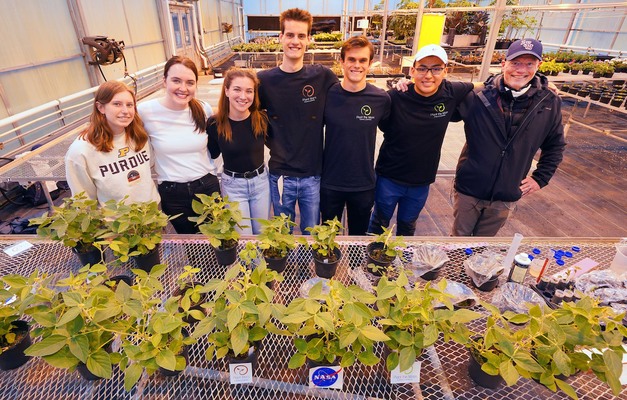With their lives packed into covered wagons, Marshall Porterfield's great-grandparents made their journey across the Great Plains in the Oklahoma Land Rush of 1889, becoming a part of agriculture's pioneering history.
More than a century later, Porterfield, professor of agricultural and biological engineering, finds himself pioneering as his family once did, except this time, his sights are set out of this world.
"Space is the ultimate frontier," Porterfield said. "If we can build capabilities to live, explore, and extend our time spent there, we will eventually move towards colonization. But that all has to be based on agriculture."
While working on his doctorate in the mid-1990s, Porterfield spent summers as a fellow at NASA's Kennedy Space Center, contributing to the Controlled Ecological Life Support System (CELSS) program. A decade-long initiative launched in 1985, CELSS sought to identify ways to support large crews throughout missions. Utilizing a leftover vertical chamber from the late 1950s built to test the Mercury capsule, NASA began to experiment with the concept of closed agriculture.
Their research, focused on understanding how plants would regulate carbon dioxide and oxygen when closed off from the outside by using hydroponic farming, explored future opportunities for self-sustaining agriculture during space missions.
The results showed crops in controlled environment settings, like the leftover vertical chamber, could produce double or triple the yields compared to what was typically grown in a field. Porterfield has been able to push these foundations by controlling the amount and duration of light on the plants in addition to the chamber's temperature. This allows for new crops, such as coffee and cacao, to thrive in hydroponic settings in Indiana.
After spending decades researching methods of cultivation in zero-gravity settings, Porterfield was tapped by NASA in 2012 as director of its Space, Life, and Physical Sciences Research and Applications Division. Although living in outer space can still seem like a far-fetched dream, Porterfield explains advancements in agricultural sciences have brought society closer to achieving that goal.

A key element of his approach to developing bioregenerative agriculture for advanced life support overlaps with his work in the NASA GeneLab. Porterfield has spent the past decade advancing new tools for genomics and analyzing the effects of space travel on humans. In a recent GeneLab study, Porterfield's lab worked to find personalized medicinal approaches for astronauts through computational genomics and artificial intelligence, which he now uses to study plant, crop, and microbe genetics from an ecological engineering perspective.
Porterfield views the frontier of space much like American settlers did in the late 1800s: a new opportunity for survival. However, he believes many of the lessons those pioneers learned in their journey toward a new life have been forgotten in the modern age.
"When we settled this country, there was value to people who wanted to farm the land available," Porterfield explained. "We created human opportunities every step of the way, and that's what drove the pioneering of this country: individual people trying to achieve their potential as human beings. Space hasn't been doing that. It's become stratified and elitist."
But the capability to live sustainably in outer space is there, Porterfield said, noting it will take time, much like the space race in the mid-20th century, for the next key steps to be taken.
"An environment of tension, which is typically associated with competition, breeds innovation. No one innovates if everything is good; for some reason, humans are just built that way," Porterfield said. "We found our innovation from the moon because of President Kennedy's deadline he set in the early 1960s."
In his youth, Porterfield would make trips back to his family's home in Oklahoma to visit his grandmother. He would listen to her stories about his great-grandparents' struggle to survive the early days when claims on their land were made, and later during the Dust Bowl. Like his great-grandparents forging a new frontier for their family, Porterfield hopes to play a similar role in the journey towards colonizing the lunar surface.
Source: ag.purdue.edu
